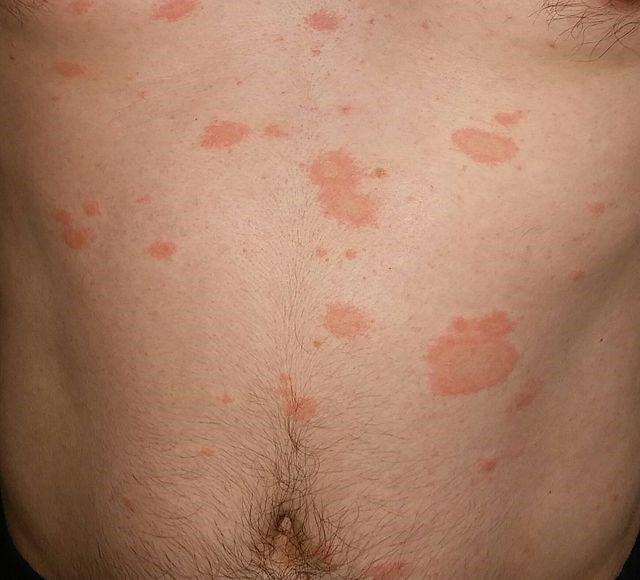Pityriasis rosea
Peer reviewed by Dr Colin Tidy, MRCGPLast updated by Dr Hayley Willacy, FRCGP Last updated 30 Dec 2024
Meets Patient’s editorial guidelines
- DownloadDownload
- Share
Pityriasis rosea is a self-limiting rash, In other words it goes away on its own without any treatment. Although the rash can be quite dramatic, the illness is very mild. It most commonly affects young adults but can affect all ages.
In this article:
Continue reading below
What is pityriasis rosea?
Pityriasis rosea is a self-limiting rash that can occur both in adults and in children. Pityriasis rosea is more common in children and young adults. It is most common in people aged between 10 and 35 years. It is more common in the spring and autumn months. Unfortunately, having pityriasis rosea during the first 15 weeks of pregnancy is associated with miscarriage and preterm delivery.
Pityriasis rosea symptoms
Most people with pityriasis rosea feel perfectly well but are aware of a rash. The rash may be itchy but is not always. Some people may have:
A mild headache.
A high temperature (fever).
A feeling of sickness (nausea).
A feeling of being more tired than usual.
Any symptoms that do occur usually start before the rash appears. Some people develop intense itching before the rash first appears.
Occasionally, some people also have affected areas in their mouths - for example, blisters or ulcers.
Continue reading below
Pityriasis rosea treatment
Pityriasis rosea is a condition that will clear itself naturally. No treatment is needed.
Although this rash disappears without leaving a scar, some people find they have marks of discolouration on their skin for a few months.
There are no known pityriasis rosea remedies that will clear the rash more quickly than its natural course. The following may help if itching is a problem:
Avoid fragranced soaps, hot water, wool and synthetic fabrics.
As much as possible try not to scratch. It is thought that scratching can make itch worse and an itch-scratch vicious cycle may develop with regular scratching. (That is, you itch more because you scratch, so you scratch more because you itch more ... and so on.)
Simple creams (also called emollients) may be soothing to the skin and reduce the itching.
A menthol cream or ointment may be cooling and soothing.
Antihistamine tablets may help to reduce the itching. These can be prescribed by your doctor or bought from a pharmacy.
Your doctor may prescribe a steroid cream if your itching is more severe.
If symptoms are very severe you may be referred to a skin specialist who may advise some ultraviolet light treatment. There is no definite evidence that this is effective; however, it is often tried. Other treatments, such as aciclovir, may also be considered.
Pityriasis rosea causes
Its exact cause is unknown. No germ (bacterium, virus, or fungus) has been found in people with the rash. However, certain types of human herpes viruses may be a part of the cause. It is not associated with food, medicines or stress. However, some medicines can cause a rash which looks similar to pityriasis rosea.
What does the rash look like in pityriasis rosea?
A 'herald patch' usually appears on the skin first. This is usually an oval- or round-shaped patch which can vary from 2-5 cm in diameter. This is usually pink/red in colour. It most commonly appears on your chest or upper back. It can sometimes appear on your tummy (abdomen), neck, back, thigh or upper arms. However, many cases do not have a herald patch or it goes unnoticed.
Around 5-15 days later a more widespread rash gradually appears over about 10 days. Most commonly this is on the back or the chest and abdomen. This rash can spread over much of your body. However, it does not usually affect your face.
The rash usually consists of oval-shaped spots 1-3 cm in diameter which are pinky in colour. These spots are smaller than the herald patch. Often the spots seem to form lines in parallel with your skin creases.
This rash may be very itchy. The rash fades in time but this may take several weeks. It leaves no marks or scarring. Second attacks are very rare but have been reported.
This description is the typical case which most people seem to have. Occasionally, the rash may just affect the arms and legs. Rarely, it can cause scaling or flaking of the skin, which can be troublesome.
Pityriasis rosea on the abdomen

By Marekzerzan (Own work), CC BY-SA 4.0, via Wikimedia Commons
Further pictures of pityriasis rosea can be found at the DermNet NZ and DermIS websites - see references below.
Continue reading below
Frequently Asked Questions:
Is pityriasis rosea contagious?
Pityriasis is not usually contagious so does not spread to other people.
Do I need any tests?
Usually no tests are needed. Your doctor will be able to diagnose pityriasis rosea from the typical rash. If the rash does not go away after three months, or if the itching is very bad, you may be referred to a skin specialist (dermatologist). You may also be referred if your doctor is not sure about the diagnosis.
How long can pityriasis rosea last?
It usually lasts for 2-12 weeks but can last as long as five months. Most commonly it lasts about five weeks before going away completely. If the rash is lasting a longer time, you may need to see a skin specialist to check the diagnosis.
Can stress cause pityriasis rosea?
The exact cause for pityriasis rosea is not yet known but so far no association between pityriasis rosea and stress has been found.
Further reading and references
- Pityriasis rosea; NICE CKS, April 2020 (UK access only)
- Contreras-Ruiz J, Peternel S, Jimenez Gutierrez C, et al; Interventions for pityriasis rosea. Cochrane Database Syst Rev. 2019 Oct 30;2019(10). doi: 10.1002/14651858.CD005068.pub3.
- Pityriasis Rosea; DermIS (Dermatology Information System)
- Pityriasis rosea; DermNet NZ
Continue reading below
Article history
The information on this page is written and peer reviewed by qualified clinicians.
Next review due: 29 Dec 2027
30 Dec 2024 | Latest version

Book a free same day online consultation
Get help with common conditions under the NHS Pharmacy First scheme.

Feeling unwell?
Assess your symptoms online for free